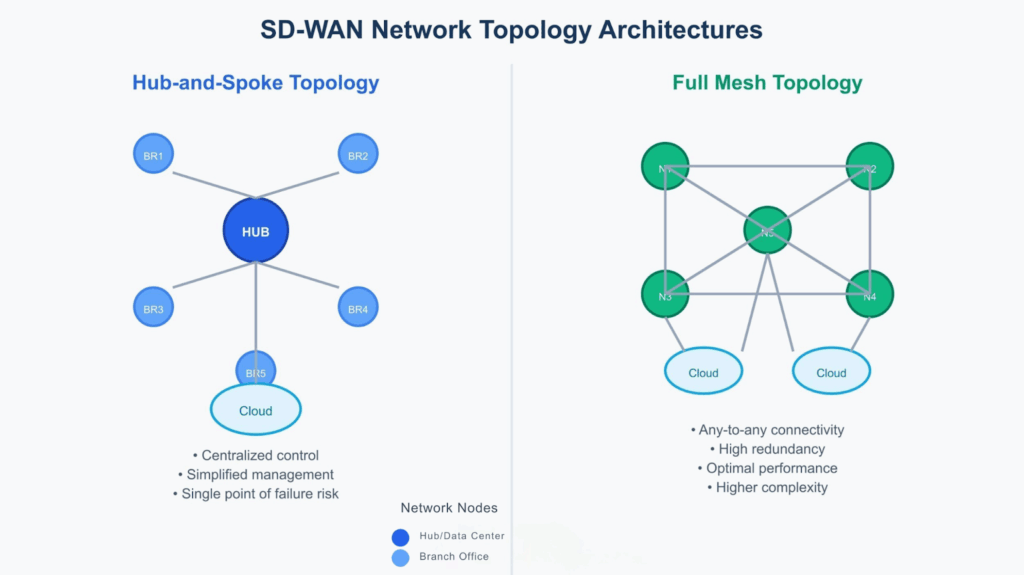The service provider network infrastructure market is valued at $159.68 billion in 2025 and projected to reach $233.44 billion by 2034, driven largely by organizations modernizing their connectivity with software-defined solutions. SD-WAN architecture has emerged as the backbone of this transformation, offering businesses unprecedented flexibility in how they design, deploy, and manage their wide area networks.
Unlike traditional networking approaches that lock organizations into rigid, expensive infrastructure, modern SD-WAN architecture enables companies to leverage multiple connection types while maintaining centralized control and enhanced security.
As enterprises accelerate their digital transformation initiatives with global spending projected to reach $3.9 trillion by 2027, understanding the nuances of SD-WAN architecture becomes critical for sustained competitive advantage. Today’s SD-WAN solutions do far more than simply replace MPLS connections—they create intelligent, adaptive networks that respond dynamically to changing business requirements and application demands.
Core Components of SD-WAN Architecture
Every effective SD-WAN architecture relies on three fundamental components working in harmony: the orchestration layer, the control plane, and the data plane. The orchestration layer serves as the brain of the operation, providing centralized policy management and network-wide visibility through intuitive dashboards. This layer enables administrators to define business intent and translate it into actionable network policies without requiring deep technical expertise at each location.
The control plane acts as the nervous system, distributing policies and routing information across the entire network fabric. Modern control planes utilize advanced algorithms to continuously monitor network conditions, automatically adjusting traffic flows to optimize performance and reliability. This intelligence extends beyond simple load balancing to include application-aware routing that prioritizes critical business traffic based on real-time network conditions.
The data plane represents the muscle of SD-WAN architecture, consisting of edge devices that execute policies and forward traffic according to centralized directives. These devices, whether physical appliances or virtual instances, create secure tunnels between locations while applying traffic engineering, security policies, and quality of service controls. The elegance of software-defined networking lies in how these components work together to create a network that’s both more capable and simpler to manage than traditional WAN architectures.
SD-WAN Deployment Models: Finding Your Fit
On-Premises SD-WAN Architecture
On-premises SD-WAN architecture gives organizations complete control over their network infrastructure by hosting controllers and management systems within their own data centers. This approach appeals to companies with strict data sovereignty requirements or those operating in heavily regulated industries where maintaining physical control over network components is paramount.
The on-premises model typically offers the lowest ongoing operational costs since organizations avoid recurring cloud service fees, though it requires significant upfront capital investment and internal expertise.
Organizations choosing this path benefit from predictable performance and the ability to customize every aspect of their network deployment. However, the trade-off comes in the form of increased complexity around scaling, updating, and maintaining the infrastructure. Companies must also ensure adequate redundancy and disaster recovery capabilities, as they bear full responsibility for system availability and performance.
Cloud-Based SD-WAN Architecture
Cloud-based SD-WAN architecture shifts the control and management infrastructure to service provider environments, dramatically reducing the complexity of deployment and ongoing operations. This model has gained significant traction as organizations recognize the benefits of leveraging provider expertise and global infrastructure. Cloud deployments typically enable faster time-to-value, with new sites coming online in days rather than months, and automatic access to the latest features and security updates.
The cloud model excels in scenarios requiring rapid scalability or global reach, as providers maintain points of presence worldwide that can optimize traffic flows and reduce latency. Modern cloud SD-WAN solutions also integrate seamlessly with major public cloud platforms, creating direct connectivity paths that bypass the public internet for improved performance and security.
Hybrid SD-WAN Architecture
Hybrid SD-WAN architecture combines the best aspects of on-premises control with cloud-based services, allowing organizations to maintain critical functions internally while leveraging cloud capabilities for enhanced reach and functionality.
This approach has become increasingly popular as companies seek to balance control requirements with operational efficiency. Hybrid models often involve keeping core network functions on-premises while utilizing cloud-based services for branch connectivity, security services, or disaster recovery.
The flexibility of hybrid architectures makes them particularly well-suited for organizations undergoing digital transformation, as they can gradually migrate functions to the cloud while maintaining existing investments and compliance requirements. This approach also enables companies to optimize costs by keeping high-volume, predictable traffic on-premises while using cloud services for burst capacity or specialized functions.
Network Topology Strategies for SD-WAN Success
Hub-and-Spoke Topology
Hub-and-spoke topology remains the most common SD-WAN architecture, particularly for organizations transitioning from traditional MPLS networks. In this model, regional or central hubs serve as aggregation points for branch locations, providing shared services like internet access, security inspection, and data center connectivity. This approach simplifies network management and enables consistent policy enforcement across all locations.
The hub-and-spoke model offers several advantages, including simplified routing, centralized security controls, and efficient use of expensive wide-area network connections. Organizations can deploy high-capacity connections at hub sites while using more cost-effective broadband connections at branch locations. However, this topology can create bottlenecks at hub sites and may not be optimal for branch-to-branch communication patterns.
Modern SD-WAN solutions enhance traditional hub-and-spoke architectures by enabling dynamic failover and load balancing across multiple hubs, ensuring business continuity even when primary hubs experience issues. These systems can also implement regional internet breakouts to optimize cloud application performance while maintaining centralized control.

Mesh Topology Architectures
Full mesh SD-WAN topology enables any-to-any connectivity between all network locations, eliminating the bottlenecks inherent in hub-and-spoke designs. This approach has become increasingly attractive as organizations adopt cloud-first strategies and require direct branch-to-branch communication for collaborative applications. Mesh architectures leverage the intelligence of SD-WAN controllers to establish optimal paths between any two points in the network.
Partial mesh topologies offer a middle ground, providing direct connectivity between select high-traffic location pairs while maintaining hub connections for other destinations. This approach allows organizations to optimize their most critical traffic flows while managing costs and complexity. The decision between full and partial mesh typically depends on application requirements, traffic patterns, and budget considerations.
Mesh topologies excel in supporting modern work patterns where employees at any location may need to collaborate with teams at any other location. They also provide inherent redundancy, as traffic can be rerouted through multiple paths if primary connections fail. However, mesh architectures require more sophisticated traffic engineering and security policies to ensure optimal performance and protection.
Industry-Specific SD-WAN Architecture Applications
Healthcare SD-WAN Requirements
Healthcare organizations face unique challenges when implementing SD-WAN architecture, primarily due to stringent regulatory requirements and the critical nature of patient care applications. Healthcare networks must comply with HIPAA regulations while supporting bandwidth-intensive applications like medical imaging, electronic health records, and telemedicine platforms. Modern healthcare SD-WAN architectures implement microsegmentation to isolate medical devices and patient data from general network traffic.
The distributed nature of healthcare delivery, spanning hospitals, clinics, laboratories, and administrative offices, makes SD-WAN architecture particularly valuable for creating seamless connectivity while maintaining security boundaries. Healthcare organizations increasingly rely on cloud-based applications for everything from patient management to financial systems, requiring SD-WAN solutions that can optimize cloud connectivity while ensuring data protection.
Real-time applications like telemedicine and remote patient monitoring demand consistent, low-latency connectivity that traditional MPLS networks struggle to provide cost-effectively across multiple locations. SD-WAN architecture enables healthcare organizations to prioritize these critical applications while using cost-effective internet connections for less critical traffic.
Manufacturing SD-WAN Deployment
Manufacturing environments present distinct challenges for SD-WAN architecture, including the need to connect industrial systems, support real-time operations, and manage traffic across geographically distributed facilities. Gartner research indicates that SD-WAN adoption in manufacturing is driven by the need to optimize network connections to cloud-based applications while gaining improved agility for plant floor applications. Modern manufacturing relies heavily on Industrial Internet of Things (IIoT) devices that generate massive amounts of data requiring secure, reliable transmission to cloud-based analytics platforms.
The 24/7 nature of manufacturing operations demands network architectures that can provide consistent uptime even during maintenance windows or unexpected outages. SD-WAN solutions designed for manufacturing environments typically include specialized features for industrial protocols and can integrate with existing plant floor networks without disrupting production systems.
Edge computing integration has become increasingly important in manufacturing SD-WAN architectures, enabling real-time processing of sensor data and machine learning applications that optimize production efficiency. These architectures must also support the growing trend toward lights-out manufacturing, where remote monitoring and control capabilities are essential for maintaining operations.
Financial Services Considerations
Financial institutions require SD-WAN architectures that prioritize security, compliance, and availability above all other considerations. The highly regulated nature of financial services demands solutions that can maintain detailed audit trails, implement strict access controls, and ensure data protection across all network segments. Financial organizations are increasingly adopting SD-WAN for simplified network management while meeting stringent regulatory requirements.
Branch banking operations present unique challenges, as each location must maintain connectivity for customer-facing applications, ATM networks, and back-office systems. SD-WAN architecture enables financial institutions to standardize branch connectivity while providing the flexibility to adapt to local requirements and regulations. The ability to implement zero-trust security models through SD-WAN has become particularly important as financial services embrace digital transformation.
Disaster recovery and business continuity planning are critical components of financial services SD-WAN architecture. These organizations require solutions that can rapidly redirect traffic, maintain compliance during failover scenarios, and provide detailed reporting for regulatory authorities.
5 Essential SD-WAN Architecture Planning Factors
When designing your SD-WAN architecture, five critical factors will determine the success of your deployment and long-term operational efficiency.
1. Application Performance Requirements: Modern businesses depend on a complex mix of on-premises, SaaS, and cloud-native applications, each with distinct performance requirements. Understanding these needs before architectural decisions ensures your SD-WAN can properly prioritize traffic and optimize user experiences across all locations.
2. Security and Compliance Frameworks: Your SD-WAN architecture must align with industry regulations and corporate security policies from day one. This includes planning for data sovereignty requirements, implementing appropriate encryption standards, and ensuring compliance reporting capabilities are built into the design.
3. Scalability and Growth Planning: Successful SD-WAN architectures anticipate future requirements rather than simply addressing current needs. Consider planned acquisitions, new market expansion, and evolving application requirements when selecting architectural approaches and vendor platforms.
4. Integration with Existing Infrastructure: Most organizations cannot implement SD-WAN in a vacuum—successful architectures must integrate with existing security tools, network management systems, and operational processes. Planning these integrations early prevents costly rework and operational disruptions.
5. Cost Optimization Strategy: While SD-WAN typically reduces networking costs compared to MPLS, architectural decisions significantly impact ongoing expenses. Balancing connection types, considering managed connectivity services, and planning for operational overhead ensures optimal total cost of ownership.
Migration Strategies and Implementation Best Practices
Successful SD-WAN architecture implementation requires a phased approach that minimizes business disruption while gradually capturing the benefits of software-defined networking. Most organizations begin with pilot deployments at non-critical locations to validate architectural decisions and operational procedures before expanding to mission-critical sites. This approach allows teams to refine policies, test failover procedures, and train staff on new management interfaces.
The parallel operation phase involves running SD-WAN alongside existing WAN infrastructure, enabling gradual traffic migration and confidence building. During this phase, organizations can validate application performance, fine-tune security policies, and establish operational procedures. According to Gartner research, organizations that follow structured migration approaches are 40% more likely to achieve their expected business outcomes.
Change management becomes particularly critical during SD-WAN migrations, as the technology fundamentally changes how network teams operate and troubleshoot issues. Successful implementations invest heavily in training and documentation, ensuring that teams understand both the technical capabilities and operational implications of their new architecture. The transition period also provides opportunities to evaluate SASE integration strategies for enhanced security and simplified management.
ROI Analysis and Performance Metrics
Modern SD-WAN architecture delivers measurable business value that extends far beyond simple cost savings from MPLS replacement. Organizations typically experience 30-60% reductions in WAN costs, but the more significant benefits often come from improved application performance, enhanced agility, and reduced operational complexity. Digital transformation spending is projected to reach $3.9 trillion by 2027, with network modernization representing a significant portion of these investments.
Quantifying SD-WAN benefits requires establishing baseline metrics before implementation and tracking improvements across multiple dimensions. Network availability improvements often exceed 99.9% with properly designed SD-WAN architectures, while application response times typically improve by 20-40% due to optimized routing and traffic prioritization. The operational benefits include reduced mean time to repair network issues and faster deployment of new locations.
Organizations should also measure less tangible benefits like improved employee productivity, enhanced customer experiences, and increased business agility. The ability to rapidly deploy new locations, adapt to changing business requirements, and integrate with cloud services creates competitive advantages that are difficult to quantify but critically important for long-term success.
Future-Proofing Your SD-WAN Architecture
The convergence of SD-WAN with emerging technologies like artificial intelligence, 5G networking, and edge computing is reshaping architectural possibilities for forward-thinking organizations. AI-driven network management is becoming standard in advanced SD-WAN platforms, enabling predictive analytics, automated troubleshooting, and intelligent traffic optimization that continuously improves performance without human intervention.
SASE (Secure Access Service Edge) integration represents the next evolution of SD-WAN architecture, combining networking and security functions into unified cloud-delivered services. This convergence simplifies management while providing enhanced security capabilities that traditional architectures cannot match. Organizations planning SD-WAN deployments should evaluate SASE-ready platforms to ensure their investments remain relevant as security requirements evolve.
The integration of 5G and edge computing capabilities will fundamentally change how organizations think about WAN architecture, enabling ultra-low latency applications and distributed computing models that were previously impossible. Forward-looking SD-WAN architectures incorporate edge computing nodes and 5G connectivity options to support these emerging use cases while maintaining centralized management and security controls.
Transform Your Network with Expert SD-WAN Architecture
The journey to software-defined networking success requires more than just selecting the right technology—it demands strategic planning, expert implementation, and ongoing optimization to deliver sustained business value. As organizations worldwide invest trillions in digital transformation initiatives, those with thoughtfully designed SD-WAN architectures gain competitive advantages through improved agility, enhanced security, and reduced operational complexity.
The complexities of modern SD-WAN architecture—from comparing deployment models to integrating with SASE frameworks—require expertise that goes beyond vendor specifications. Successful implementations balance technical capabilities with business requirements, ensuring that architectural decisions support both current needs and future growth.
BCM One delivers comprehensive SD-WAN architecture services that transform network infrastructure into strategic business enablers. Our experts design tailored solutions that optimize performance, enhance security, and reduce costs while providing the foundation for future innovations. Contact us today to discover how our proven SD-WAN architecture expertise can accelerate your digital transformation journey.
Frequently Asked Questions
What’s the difference between SD-WAN architecture and traditional WAN design? SD-WAN architecture separates network control from hardware, enabling centralized management and policy distribution across diverse connection types. Traditional WANs require manual configuration of individual devices and typically rely on expensive MPLS circuits, while SD-WAN can leverage any connection type and automatically optimize traffic flows based on real-time conditions.
How does SD-WAN architecture impact security compared to MPLS networks? Modern SD-WAN architectures often provide enhanced security compared to traditional MPLS through built-in encryption, application-aware filtering, and integration with advanced security services. While MPLS provides inherent traffic separation, it requires additional security measures at endpoints, whereas SD-WAN can implement comprehensive security policies throughout the network fabric.
Can SD-WAN architecture support real-time applications like voice and video? Yes, SD-WAN architectures excel at supporting real-time applications through quality of service controls, traffic prioritization, and path optimization. Advanced SD-WAN platforms can automatically detect voice and video traffic and route it through the best available paths while providing performance guarantees that often exceed traditional MPLS capabilities.
What role does cloud connectivity play in SD-WAN architecture design? Cloud connectivity is central to modern SD-WAN architecture, with most platforms providing optimized paths to major cloud providers and SaaS applications. This includes features like cloud on-ramps, direct peering relationships, and application-specific optimizations that improve performance while reducing costs compared to backhauling traffic through data centers.
How long does it typically take to implement SD-WAN architecture? Implementation timelines vary significantly based on network complexity and organizational requirements, but most SD-WAN deployments complete within 3-6 months for the initial rollout. Pilot phases typically take 4-6 weeks, while full production deployments can be phased over several months to minimize business disruption and allow for proper training and optimization.





